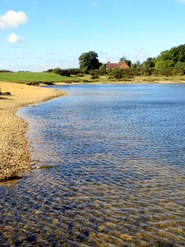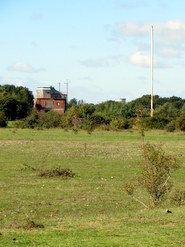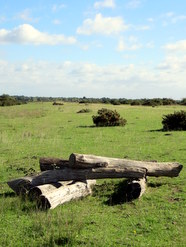Compartment 14 is the central one of three occupying the long east-west strip between the former northern taxiway and Bury's Bank Road. The road defines the northern boundary, while the southern boundary follows old airbase features, with several large incursions of compartment 16 (former runways, taxiways and hardstanding). There is no division into subcompartments, but the compartment comprises two very distinct zones:
-
A central area encompassing...
- the main visitor car park and surrounding grassland
- the control tower and its surrounding compound. These are owned by Greenham Parish Council and not part of this management plan.
- the Rangers' workshop (Estovers, formerly airbase building number 616) and service yard, an adjacent stock handling pen and a small area of heathland.
- Another warehouse-style former airbase building (number 150) .
This central area is not common land, and is fenced off from the main common and therefore not grazed. However, apart from the control tower and building 150 the utilty areas fall under BBOWT's management agreement with West Berkshire Council, since they form an integral part of the Greenham and Crookham Commons countryside site.
- The remainder of compartment 14, extending both east and west of the central utilty area, is grassland within the grazed part of the main common.
General description and evaluation of ecology
The car park area being ungrazed offers some variation from the habitats of the main common. There is mixed grassland, some of it distinctly longer and more tussocky than on the grazed area, with scrub surrounding the gravelled parking bays. Items of military historical interest in the car park area include the control tower and three large metal fuel tanks.
The grassland outside the car park and utility area is moderately species-rich in places, particularly on the thinner soils near the incursions of compartment 16. Large areas of blackthorn and hawthorn along with some bramble and gorse occur on the north side of the compartment along the Bury's Bank Road edge. There are three permanent ponds to the east and two to the west of the car park, the latter being quite large and deep. The ponds are good for dragonflies and damselflies, especially those that have developed a good number of pond plants and marginal vegetation since restoration. East of the utility area a flag pole remains a prominent relic of the military history.
Exotic and invasive Italian alder, planted during airbase days, is well established in, and spreading beyond, the central area.
BAP habitats
- Lowland heathland
- Ponds
- Open mosaic habitats on previously developed land
Higher Level Stewardship
Options exist for subcompartment 14.
Overall management objectives
Maintain and enhance the diversity and age structure of the grassland and hedgerows by scrub control. Remove invasive aquatic species to encourage a diverse marginal aquatic flora in the ponds. The car park area requires regular mowing during the summer, with the paths in this area maintained to prevent scrub encroachment. The area should be well maintained as it is the first contact visitors have with Greenham Common.
Compartment 14 (19.5 ha)




| Objective | Area | Method | Comment |
|---|---|---|---|
| 14.1) Amenity management of car park. | Central part of compartment. | Cut and treat gorse and bramble. Hedge cut bramble banks to keep controlled. Keep grass cut around visitor area. Mow every 2 to 3 months areas around car park and around visitor signs. Mow whole area annually in Autumn.
Maintain access around historically significant buildings/objects including fuel tanks and control tower. |
|
14.2) Maintain diversity and extent of heathland where possible.
HLS objectives |
Fenced area adjacent to Estovers (building 616). | Mow small sections each year. Control scrub and bramble. | Part of this area is used for bird ringing. |
14.3) Maintain current extent of grassland and, where possible, increase extent.
HLS objectives |
All grassland in compartment. | Control scrub and gorse, treat stumps. Create small scrapes for bare open areas. Keep gravel banks clear of scrub. Control ragwort as necessary.
On areas excluded from grazing in the car park area, mow annually, remove cuttings. Leave a 2 m strip around edge, and scattered clumps of scrub, for variety and cover. |
|
| 14.4) Eradicate Italian alder. | Throughout compartment. | Cut, treat stumps. In grazed areas, initially target specimens which have outgrown the reach of cattle browsing and are able to produce catkins and seed. | |
| 14.5) Maintain openness of unvegetated slopes around ponds. | All ponds in compartment. | Cut or uproot gorse, bramble, birch and other scrub. |